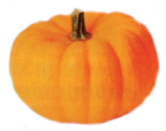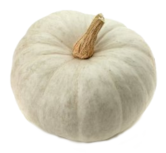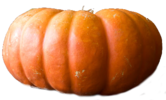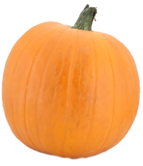Pumpkin
| J | F | M | A | M | J | J | A | S | O | N | D | |
|---|---|---|---|---|---|---|---|---|---|---|---|---|
| Sow Indoors | ||||||||||||
| Sow Direct |
Type: Vegetable
Soil / Location
A sunny spot protected from strong winds is essential.
The soil must be well drained and rich in humus, the more the better. I fill each hole at least 30x30cm with garden compost and paper at the bottom into which goes a single plant. For bush varieties 60cm between each plant is fine – 90cm for vines (unless growing them upwards).
Pumpkins like to sprawl out and need plenty of space. Vining Pumpkins require a larger area to run, whilst semi-vining and bush varieties can be well contained. If space is tight just keep turning the branches back to the centre to prevent spreading and over-running other plants.
Sowing and Planting
For an early start (Mid / Late Apr) place a single seed edgeways 1-2cm deep in seed compost in a 8cm pot. The critical part is temperature, these need at least 18°C continuous soil temperature (preferably more to maximise germination rates) until germinated, so a propagator, well heated greenhouse or airing cupboard is ideal. Gradually harden off seedlings after the last frost before planting outdoors. The most common reason for poor / zero germination is low / uneven soil temperature coupled with too much moisture.
Outdoors from around Jun you can plant direct if the weather is warm, however I would advise planting up to 3 seeds per hole and thinning to the strongest, as you have less time to plant more if any fail. Also the plants will struggle with the shorter growing period if it is a poor wet summer.
Maintenance
Keep the soil moist – water copiously around the plants, not over them.
Placing a mulch / black polythene before the fruit formation helps later on keeping the fruit clean and ripening.
Keep weed free to allow air circulation.
Once the fruits start to swell feed every 14 days with a tomato type fertilizer, these are greedy plants. Limit larger fruiting varieties to 2-3 fruits.
Harvesting and Storing
The most important part of harvesting is making sure you harvest them before the first frost. As the Pumpkin approach maturity and are ready to harvest, you’ll notice that the fruit stems will start to dry out and wither. Depending on where you live, you can expect to start harvesting in late August to September.
Because of the vast varieties of sizes and colours, the rule of thumb for harvesting Pumpkin is when they are a full size and have a deep rich colour. The rinds should be hard to the touch. If you harvest your Pumpkins too early, they may lack flavour and not keep well. Before the first frost of winter and really wet weather is essential.
Cut through the stem and remove the Pumpkin, leaving about 6cm of the stem on the fruit. A short stem can lead to rot. This may not be possible with smaller varieties, however. In these cases, preserve as much as the stem as possible. It's also important not to damage your Pumpkin when harvesting and storing, as they can go bad more quickly. Try avoiding manually breaking the stem at all costs.
Store the Pumpkins in a dry place with temperatures under 16°C.
Winter Pumpkins are best "cured" before storing. Curing your pumpkin requires storing them in higher temperatures (around 20°C or slightly higher) for at least fifteen days (a windowsill or greenhouse is fine). You can then move them to a cool, dry place. Never store the fruit where there is a risk of freezing.
Varieties
Jack Be Little
Small Palm sized fruits. You can serve one per person.
Baby Boo
A tiny white pumpkin. Cute, but not very practical.
Cinderella
Fruits are 4.5 to 7kg in weight. Ready to harvest around mid-September.



